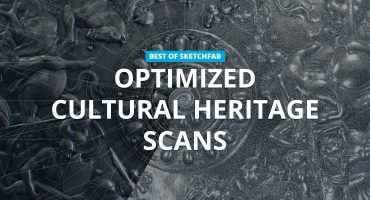My name is Edward Gonzalez and I am a 7th grade classroom teacher in the Bakersfield City School District and an adjunct lecturer at California State University, Bakersfield (CSUB). I also just finished up my first year in CSUB’s Doctoral in Educational Leadership Studies Program where I am researching how we can make sure that our lowest achieving and low socioeconomic students take advantage of the newest technologies in education.
https://skfb.ly/SCuW
This assignment for ancient Mesopotamia required that students include two rivers, fertile land between the rivers, and irrigation canals. The model was created in 3DTin.
For the last couple of years my 6th and 7th grade students have created their own “Virtual Museum.” Typically students would pick illustrations from our world history textbook and model them using 3DTin or SketchUp. Cultural heritage and 3D models through Sketchfab has potential to make learning more equitable for many disadvantaged students because it gives everybody an opportunity to share their models. As my professor Dr. Mahmoud Suleiman says, “equality lets you sit at the table and equity ensures you have a voice.” This is the unique role that Sketchfab plays because it allows students to both produce and consume content.

There is something special that happens when a student is able to hold their own VR experience and share it at home. These digital tools allow everyone to tell their own unique cultural stories. Our school district embraces the idea that students must have both a choice and voice in their education, and Sketchfab helps students meet those needs in my classroom.
https://skfb.ly/678OG
This model was based on the ancient Mayans. The student created the model in SketchUp and exported it to Sketchfab.
Every student should have the opportunity to decide how they will share their knowledge. If a student wants to do a history worksheet, it should be OK. Likewise, if a student would rather create a historical 3D model and publish it to VR, that should be ok as well. In a perfect world, students would also have the option to make a video, animation, or podcast. In education, we tend to rely on numbers and letters to measure learning, but we all know you can measure knowledge with more than a paper and pencil.

The original lessons for 3D and virtual reality were during 6th grade English class. The goal was to engage the students in high level design and development in order to then explain the experience through writing. The layout for the virtual reality essay included:
- an introductory paragraph
- a body paragraph on VR research with NewsELA.com
- a body paragraph on creating 3D
- a body paragraph on exporting to Sketchfab
- a conclusion
The video below is a tutorial created by a 6th grade student. The student demonstrates how to export a model from 3DTin to Sketchfab. I would typically teach the whole lesson to the class but the students would always learn more from one-on-one peer tutors and tutorials. I was eventually able to integrate 3D and VR into our math and history content.
Without a doubt The Lion Panel of Chauvet, France model by Ancient Art Archive was one of the class favorites on Sketchfab. In 6th grade the students learn about early man and the Chauvet painting showed kids the level of talent early man had with art. The sketch-style of the cave paintings made the entire subject relatable to the children because many of them like to sketch during class. I remember joking with the kids and saying, “I bet that first caveman artist wasn’t appreciated either. His cave-dad probably said things like ‘come on son, why don’t you get a real job like your brother and go hunt sabre-tooth tigers?”
Here are some more examples of student created 3D:
https://skfb.ly/SsOt
This is one of the first projects of the 2016-2017 school year. Students were required to create a representation of Chauvet Cave in 3DTin.
https://skfb.ly/Kur7
This 3DTin model represents a street in ancient Mohenjo Daro. The requirement was that the buildings must be square and have water wells. Mohenjo Daro is known for being an early civilization with organized streets and running water.
This 3DTin model represents a Nubian pyramid from ancient Kush.
https://skfb.ly/YULq
This is a model from our open VR competition created by a 7th grade student with SketchUp.
Special thanks to Debra Dillard, Deanna Clarke, and Rayshell Fambrough at the Bakersfield City School District for supporting the project.
For lessons on implementing VR in your middle school classroom visit eddiesclass.com or @EddiesClass on Twitter.



